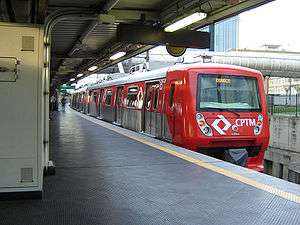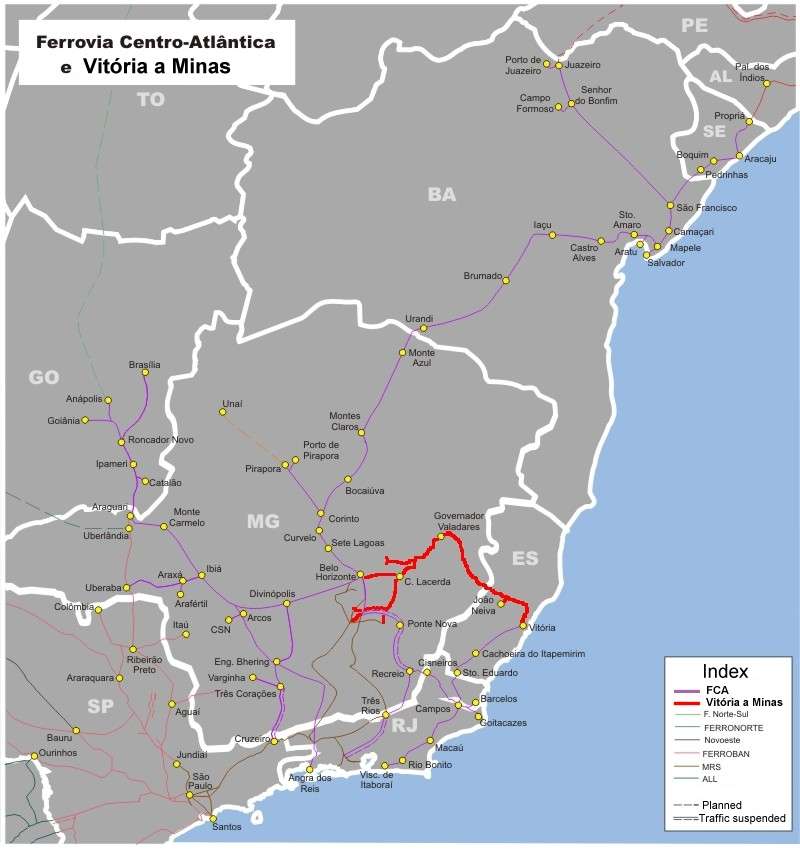Rail transport in Brazil

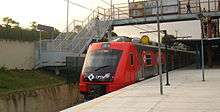
Rail transport in Brazil began in the 19th century and there were many different railway companies. The railways were nationalised under RFFSA (Rede Ferroviária Federal, Sociedade Anônima) in 1957. Between 1999 and 2007, RFFSA was broken up and services are now operated by a variety of private and public operators, including América Latina Logística, Companhia Paulista de Trens Metropolitanos and SuperVia.
Track gauge
The rail system in Brazil operates on four rail gauges:
- Broad gauge: 4,932 km 1,600 mm (5 ft 3 in) gauge
- Metre gauge: 23,773 km 1,000 mm (3 ft 3 3⁄8 in) gauge
- Dual gauge: 396 km 1,000 mm (3 ft 3 3⁄8 in) and 1,600 mm (5 ft 3 in) gauges (three rails) (1999 est.)
- Standard gauge: 202.4 km 1,435 mm (4 ft 8 1⁄2 in) gauge:
- line 5 of the São Paulo Metro, so that it can use "off the shelf" equipment.
- Estrada de Ferro do Amapá in the middle of the Amazon Rainforest also used standard gauge.
- Total: 29,303 km (1,520 km electrified).
A 12 km section of the former 2 ft 6 in (762 mm) gauge Estrada de Ferro Oeste de Minas is retained as a heritage railway.
Metros
Metros operating, and under construction:
- Belo Horizonte Metro
- Brasília Metro
- Fortaleza Metro (under construction)
- Maceió Metro (under construction)
- Porto Alegre Metro
- Recife Metro
- Rio de Janeiro Metro (Rio de Janeiro Metropolitan Area)
- Salvador Metro
- São Paulo Metro (São Paulo Metropolitan Area)
- Teresina Metro
Tramways
Steam-powered, horsedrawn and electric tramways operated in Brazil from 1859 until 1989, new systems were introduced in the 1980s and 90s in Rio de Janeiro and Campinas with no success,[1] nevertheless, that may change soon as studies are being conducted to introduce tramway systems in Goiânia,[2] and Curitiba now plans a "light metro" to replace "bus rapid transit (BRT)" in a major corridor,[3] and in Cariri, the Cariri MetroTram that will run between Crato and Juazeiro do Norte is under construction.[4]
History:
Brazil is the fifth largest country in the world and had a hundred tram systems, almost as many as all the other Latin American countries combined. It had one of the world's first tramways: an 1859 system in Rio de Janeiro predates street railway experiments in all European countries except France. Trams still operate in Rio today, over 130 years later. Brazil has one of the first steam-powered street railways and had the world's first steam locomotive designed specifically to work on the street. It had one of the world's first electric trams, Rio de Janeiro had electric streetcars before London, Paris, Rome, Madrid, Lisbon and any other city in Latin America. Niterói, Brazil, may have been the first place where the trams were successfully fed by storage batteries. Brazil had the largest collection of American streetcars built outside the United States, and had the world's largest foreign-owned street railway empire.
Five trams were still operating in 1989, the Santa Teresa and Corcovado lines in Rio de Janeiro; the Campos do Jordão line near São Paulo; the Itatinga line near Bertioga; and the tourist tram in Campinas. A sixth line, the Tirirical tram near São Luís, ceased operation in 1983 but may be reactivated.[5]
Currently, there are vintage tramways operating in:
- Campinas – Heritage Tram[6]
- Campos do Jordão – Interurban Tramway[7]
- Itatinga – Non-public Tramway[8]
- Rio de Janeiro – Santa Teresa Tram[9]
- Santos – Santos tramways, Heritage Tramway[10]
- Belém – Heritage Tramway[11]
Future developments
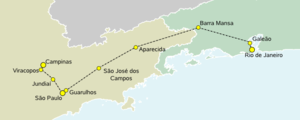
High-speed rail
In September 2008, Brazil's Transportation Ministry announced a high-speed train project for the world cup connecting São Paulo, Rio de Janeiro and Campinas. This would cost US$15 billion. These lines will use 1,435 mm (4 ft 8 1⁄2 in) standard gauge.
International link
On 2008-08-23, a deal was signed between Argentina, Brazil and Venezuela to develop an electrified long distance passenger railway link between these countries. A minor hurdle is the use of both 50 Hz and 60 Hz railway electrification systems. There is also a confusion of gauges (3 gauges of 1435mm, 1600mm and 1676mm) to overcome.[12]
New freight line
A new metre gauge line from Maracaju via Cascavel to Paranaguá for agricultural products is proposed.[13]
Gauge conversion
All 1,600 mm (5 ft 3 in) lines are possibly proposed to be converted to 1,435 mm (4 ft 8 1⁄2 in) standard gauge.[14]
Railway links with adjacent countries
| Country | Location | Line | Gauge | Brazilian Gauge | Line | Location |
|---|---|---|---|---|---|---|
| Argentina | Paso de los Libres | Urquiza | 1,435 mm (4 ft 8 1⁄2 in) | 1,000 mm (3 ft 3 3⁄8 in) | unknown | Uruguaiana |
| Bolivia | Puerto Suárez | unknown | 1,000 mm (3 ft 3 3⁄8 in) | 1,000 mm (3 ft 3 3⁄8 in) | unknown | Corumbá |
| Uruguay | Rivera | Linea Rivera | 1,435 mm (4 ft 8 1⁄2 in) | 1,000 mm (3 ft 3 3⁄8 in) | unknown | Santana do Livramento |
| Uruguay | Rio Branco | Linea Rio Branco | 1,435 mm (4 ft 8 1⁄2 in) | 1,000 mm (3 ft 3 3⁄8 in) | unknown | Jaguarão |
Heaviest trains
Brazil has some of the heaviest iron ore trains in the world, and these run on the metre gauge track of the EFVM railway, these trains are pulled by a fleet of specially built locomotives that utilize 4-axle trucks or two pairs of 2-axle trucks with span bolsters. The first model of locomotive built specially for this duty was the DDM45, created by EMD in the 1970. 83 examples were delivered to the EFVM. Later, in the early 1990s the EFVM also ordered BB40-8M models from General Electric and continues to order further BB40-9W models, also from GE.
However, a major power shortage occurred in 2002 across the Brazilian narrow-gauge systems. As new locomotives would be too expensive for many railways, or would take to long to be delivered for others, the solution was to buy second-hand standard gauge locomotives and fit them with new metre gauge bogies. The number of axles was increased due to limitations with tractive effort output from the smaller meter-gauge traction motors.[15] The dual-truck axle conversion was fairly expensive, so not all railways could afford it; some, such as ALL (América Latina Logística) retained the original trucks, narrowing them to fit the new gauge and fitting smaller traction motors. Additional issues arose with the extra axles, primarily due to the increased length of locomotives creating excessive drawbar swing, causing some derailments on tighter curves.
History
Railway companies
- Pre-1957 companies - this list is incomplete
- Estrada de Ferro Central do Brasil, nationalised 1957
- Estrada de Ferro Oeste de Minas, a part of this railway still operates as a heritage railway
- Estrada de Ferro Rio d'Ouro (Portuguese Wikipedia article)[16]
- Estrada de Ferro Santos-Jundiaí, nationalised 1957 - 1,600 mm (5 ft 3 in) gauge
- Estrada de Ferro Sorocabana (Portuguese Wikipedia article)[17]
- São Paulo Railway, nationalised 1946, renamed Estrada de Ferro Santos-Jundiaí 1948
State ownership
- RFFSA (Rede Ferroviária Federal, Sociedade Anônima). Created in 1957 and dissolved between 1999 and 2007.
Locomotives
-
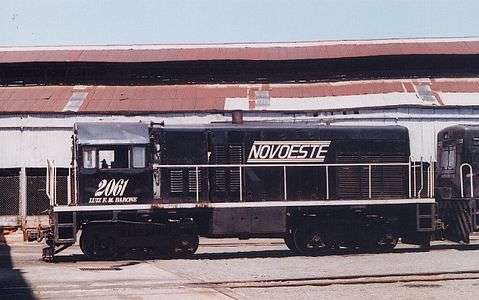
GE U5B NOVOESTE #2061 - "Luiz F. M. Barone"
-
GE U5B FCA (Ferrovia Centro-Atlântica) #2039
-

GE C30-7 #9220 of América Latina Logística
-
EMD DDM45 from Estrada de Ferro Vitória a Minas, of VALE.
Maps
See also
| Wikimedia Commons has media related to Rail transport in Brazil. |
References
- ↑ Light Rail in Brazil Two Sad Stories Retrieved on 3 July 2009
- ↑ www.lightrailnow.org Goiânia (Brazil) eyes light rail transit system Retrieved on 3 July 2009
- ↑ www.lightrailnow.org Curitiba (Brazil) now plans a "Light Metro" to replace "BRT" in a major corridor Retrieved on 3 July 2009
- ↑ www.seinfra.ce.gov.br Metrô do Cariri inicia obras das nove estações de passageiros (In Português) Retrieved on 3 July 2009
- ↑ The tramways of Brazil Retrieved on 26 June 2008
- ↑ The Tramways of Campinas Retrieved on 26 June 2008
- ↑ The Tramways of Jordao Retrieved on 26 June 2008
- ↑ The Tramways of Itatinga Retrieved on 26 June 2008
- ↑ The Tramways of Rio de Janeiro Retrieved on 26 June 2008
- ↑ Santos The Tramways of Santos Retrieved on 26 June 2008
- ↑ The Tramways of Belém Retrieved on 26 June 2008
- ↑ Xinhua (2008-08-21). "Venezuela, Argentina begin construction of railway linking their capitals". China Daily. Retrieved 2008-08-21.
- ↑ Railway Gazette International April 2009, page 62
- ↑ Railways in Brazil
- ↑ International Railway Journal, July, 2005 by Theodor A. Gevert – Re-gauging offers a cost-effective fleet upgrade
- ↑ pt:Estrada de Ferro Rio d'Ouro
- ↑ pt:Estrada de Ferro Sorocabana
| ||||||||||||||||||||||||||||||||||||||
| ||||||||||||||||||||||
| ||||||||||
